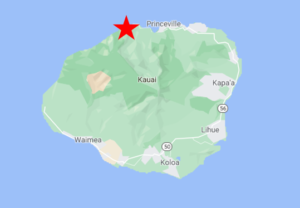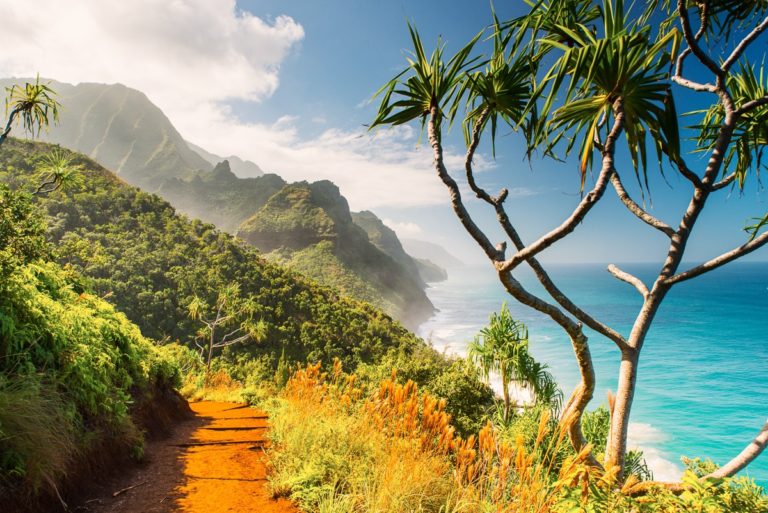Ha’ena State Park, Kauai, Hawaii

Driving counterclockwise on Kauai, the end of the line is Ha’ena State Park, which includes Ke’e Beach and the head of the famous Kalalau Trail along the Na Pali Coast. The beach areas and seaside cliffs along the trail good for seabirds—especially “Hawaiian Noddy”, which is highly localized and uncommon elsewhere on Kauai, but also Yellow-billed Tropicbird, Red-footed and Brown Boobies, and Great Frigatebird. Most other birds present can be found more easily elsewhere, but the park is a notably reliable site for Red Junglefowl.
Orientation
Directions
Ha’ena State Park is the terminus of the Kuhio Highway (a.k.a. Highway 560), the farthest drivable point on Kauai’s north shore, about an hour and 10 minutes’ drive (38 miles) from Lihue Airport.
The park gives access to two heavily visited attractions, the Kalalau Trail and Ke’e Beach. At times of peak visitation, touristic demand far outstrips the park’s capacity and the road is clogged with more vehicles than it can accommodate.
For non-residents of Hawaii, to visit the park in one’s own (i.e., rental) vehicle, it is necessary to purchase a parking reservation in advance. The parking reservation costs $10 and specifies a portion of the day when it is valid (e.g., 12:30 p.m. – 5:30 p.m.) and includes the park entry fee for all occupants of the vehicle.
To ameliorate the traffic and avoid headaches, it may be preferable to use the North Shore Shuttle instead of attempting to drive one’s own vehicle to the park. This service has been reconstituted following a period of road reconstruction necessitated by floods in 2018. Details are subject to revision, so consult the website. As of December 2020, the place to park and catch the shuttle is the Waipa Park-&-Ride, just west of the village of Hanalei, at the intersection of Kuhio Highway and Kumu Road—but this is subject to change. For those who take the North Shore Shuttle, the park entrance fee is included.
Attractions
The Kalalau Trail is Kauai’s most famous hike, the path along the dramatic Na Pali Coast. It climbs above spectacular cliffs and descends into a series of verdant valleys, then after eleven miles ends at Kalalau Beach, where sheer cliffs prevent further progress by land. The scenery is awe-inspiring and the trail has become legendary as a backpacking destination.
The initial segment, two miles to Hanakapi’ai Beach, is a popular day hike. From the beach, a side-trail goes inland and after two miles reaches a waterfall. This additional hike is also popular, but the latter portion (beginning about a mile inland) becomes strenuous and potentially treacherous—especially in wet weather.

Kalalau Trail. © Sven Bannuscher
To hike beyond Hanakapi’ai Valley requires advance preparation, including a backcountry camping permit and an overnight parking permit (see below).
Birdfinding
For birdwatchers, the park is of interest mainly for the “Hawaiian Noddy”, which nests year-round in colonies near the bottoms of the cliffs, and can usually be seen from Ke’e Beach. Other seabirds often present include Yellow-billed Tropicbird and Great Frigatebird, which typically soar high along the cliffs, and Laysan Albatross and Red-footed and Brown Boobies, which sometimes cruise past the beach at fairly close range.
On the north side of the short park road, between the two parking areas, is an area of remnant taro fields, which provide open grassy habitat and a few small ponds where Red Junglefowl, Hawaiian Duck, and “Hawaiian Gallinule” regularly appear. Hawaiian Goose and Hawaiian Coot are sporadic.
In brushy areas in the park and along the trail, common songbirds include White-rumped Shama, Warbling White-eye, and Red-crested Cardinal.
Services
Accommodations
To hike the Kalalau Trail, you must first buy a camping permit for Nāpali Coast State Wilderness Park and an overnight parking permit.
Notes
Hazards & Hassles
Access to Ha’ena State Park is tightly regulated due to its history of excessive visitation and traffic congestion. An advance-purchased parking reservation (https://www.gohaena.com/) is required to park a vehicle in the park—illegally parked vehicles are subject to a $200 fine.
The Kalalau Trail to Hanakapi’ai Beach is generally safe, but hiking much beyond the beach requires preparation and respect for the conditions. The beach itself can be dangerous for swimmers, depending on the variable currents which sometimes create strong riptides.
Links